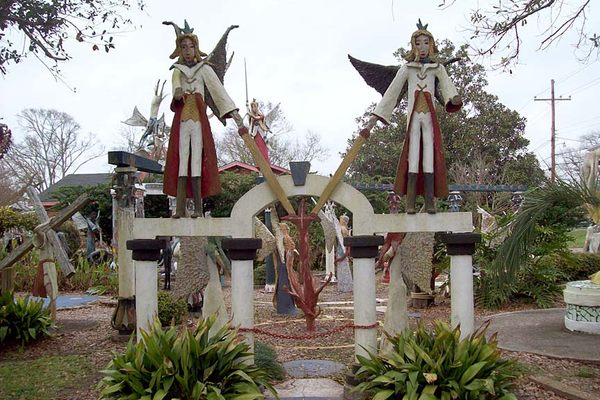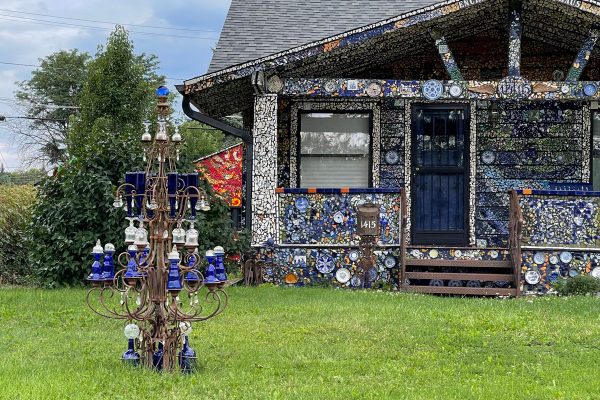Architecture of Obsession: Eight Outsider Art Gardens
Dr. Evermor’s Forevertron (photograph by Matt Bergstrom)
Around the world, self-taught builders have been inspired by dreams and daydreams to decorate their homes and yards with elaborate sculptures and artwork. These spectacular art gardens are visions of a more magical world realized through obsession. Here are eight of the world’s most stunning outsider art gardens.
PALAIS IDEAL
Hauterives, France
photograph by M.Maselli
One of the oldest documented outsider art gardens is the grandly named Palais Idéal, built by letter carrier Ferdinand Cheval in Hauterives, France.
While walking his long country mail route he often passed the time pondering architecture and world history. One day in 1879, he tripped over a rock that startled him from his reveries. Looking down, the strange shape of this stone inspired him, and he decided he must get to work now or he’d waste the rest of his life daydreaming. At first he would fill his pockets with other interesting rocks found on his route, and then later he used a wheelbarrow to gather increasing quantities of stone.
photograph by Daderot/Wikimedia
Working late each night with the experimental new modern material of concrete, he spent 33 years building his fantasy palace, which was finally complete in 1912. The structure is a romantic confection, densely covered with shapes and textures evoking exotic architecture, plants, and animals. Three colossal figures of César, Vercingétorix, and Archimedes support the Barbary Tower lookout. The trusty wheelbarrow is enshrined in a grotto inside the structure, and the strange stone that inspired the place is cemented in a place of honor as well. Along the walls are dozens of Cheval’s boastful inscriptions about his accomplishment as a lowly but patient toiler who succeeded in making his dreams a concrete reality.
photograph by Gachepi/Wikimedia
photograph by Marine69/Wikimedia
photograph by Daderot/Wikimedia
photograph by Daderot/Wikimedia
THE GARDEN OF EDEN
Lucas, Kansas
photograph by soupstance/Flickr user
On the other side of the world, in the small town of Lucas, Kansas, Samuel P. Dinsmoor was also experimenting with cement to build a backyard Garden of Eden. After retiring from farming nearby in 1905, Dinsmoor moved into town and constructed an unusual stone house in the style of a log cabin.
photograph by Aaron Sumner
Instead of an ethereal dream palace like the Palais Ideal, Dinsmoor conceived of his “Cabin Home” as a showcase for his populist political views addressing the injustices of American society. Perhaps inspired by Masonic allegorical imagery, he filled the yard with a complex tableau of dozens of three dimensional figures leading from Adam and Eve’s original sin to the modern-day struggles of workers against capitalist injustice.
Hoping that his artwork would live on as a permanent plea for a more just society, he built a stone pyramid mausoleum with a glass-fronted concrete coffin where his embalmed body still keeps an eye on his creation.
photograph by Aaron Sumner
photograph by Franklin B. Thompson
photograph via Kansas Tourism
photograph via Kansas Tourism
photograph by Nikol Lohr
photograph by Nikol Lohr
photograph by Kelly Ludwig
photograph by Kelly Ludwig
photograph by Kris Vera-Phillips
photograph by Lynae Zebest
photograph by Kelly Ludwig
WATTS TOWERS
Los Angeles, California
photograph by InSapphoWeTrust/Flickr user
In Los Angeles, Simon Rodia spent 33 years building a lacework of concrete towers nearly 100 feet tall. While they are now known as the Watts Towers, Rodia called his creation “Nuestro Pueblo.” The little village of seventeen interconnected structures around his small house was built on a triangular lot surrounded by a concrete fence decorated with colorful mosaics.
photograph by Megan Westerby
Rodia built the towers from steel bars (bent into shape using the nearby railroad tracks for leverage). The bars were wrapped with wire then covered with concrete and embedded with broken glass and crockery. By day he worked as a construction worker and brick layer, but at night he worked alone on his little village. Without scaffolding and only occasionally using a window-washer’s belt, he climbed the towers with a bucket of concrete again and again to add a little at a time.
The structures were likely inspired by towering parade floats from the Giglio festival celebrated near Rodia’s birthplace not far from Naples, Italy, but he never revealed what exactly motivated him to start building. In 1954, he gave the deed to the property to a neighbor and moved away to Martinez, California, leaving the towers behind and never returning before his death in 1965.
photograph by Parker Knight
photograph by Jason Hickey
photograph by claudiah/Flickr user
photograph by Jason Hickey
photograph by Jason Hickey
photograph by claudiah/Flickr user
photograph by collectmoments/Flickr user
JOSEP PUJIULA LABYRINTH
Argelaguer, Spain
photograph by Adam Fowler
More recently, Josep Pujiula i Vila has been building similar vertigo-inducing towers of woven willow branches in a forested area outside Argelaguer, Spain.
photograph by Adam Fowler
After building a little dam to create a personal swimming hole in 1980, Pujiula kept on building wooden structures and picnic shelters. Outsiders discovered his creation, so he surrounded it with a labyrinth of woven sticks to keep vandals and troublemakers out. However, local government officials in turn discovered that he had no permission to build on the land, and in 2002 they forced him to dismantle much of his creation.
The busy artist was soon building another labyrinth in the forest nearby. This too was partly deconstructed in 2012, but the tenacious Pujiula is still at work adding towers and tunnels. Perhaps the government is now realizing the economic value of the labyrinth as a tourist attraction, despite its lack of official safety standards.
via Atlas Obscura
photograph by Adam Fowler
ROCK GARDEN OF CHANDIGARH (NEK CHAND SANI)
Chandigarh, India
photograph by Rod Waddington
A positive example of local government support for outsider art is the sprawling Rock Garden of Chandigarh, also known as Nek Chand Sani, in India.
photograph by Rod Waddington
The garden is located on the outskirts of Chandigarh, a modernist planned city designed by architect Le Corbusier in 1947 as the capital for the newly partitioned East Punjab. While the shiny modern city was being built, local roads inspector Nek Chand scavenged trash and cast-off materials from the construction for a secret garden hidden in the forest. Working at night beginning in 1958, he ferried tons of rock and concrete on his sturdy bicycle to create a rugged fantasy park as an antithesis to the gridded streets of the city. However, he never received permission to build his garden, which was on land planned as a natural area.
Finally after eighteen years, his illegal sculpture garden was discovered by government officials. Somehow Chand’s humble demeanor and patient ambition impressed the officials, and he was able to persuade the city to open the garden as a public park, and even give him a salary as chief engineer of the garden.
photograph by Rod Waddington
The garden is now treasured by the community and has been enlarged several times by Chand and many helpers to accommodate the crowds of local sightseers who enjoy strolling the pathways among colorful statues of characters from Punjabi folklore made of cement and broken pottery. The newest parts of the garden feature waterfalls and giant swings in a restful oasis.
photograph by Rod Waddington
photograph by Rod Waddington
photograph by Rod Waddington
photograph by Lian Chang
photograph by Giridhar Appaji Nag Y
photograph by Giridhar Appaji Nag Y
DICK AND JANE’S SPOT
Ellensburg, Washington
photograph by Matt Bergstrom
Dick and Jane’s Spot is a home-grown sculpture garden located in the small city of Ellensburg, Washington.
photograph by Matt Bergstrom
Artists Dick Elliott and Jane Orleman (and their dog Spot) bought a boarded-up house with a barren yard in 1978 and rehabilitated the neglected property into a cheerful home surrounded by flowers and recycled sculptures and paintings. Dick’s art features bottle caps and reflectors in dramatic geometric patterns, while Jane’s paintings portray autobiographical and mythological themes, and their house and yard combine both the abstract and personal in a playful and colorful manner.
Though Dick passed away in 2007, Jane still maintains the garden that has become a local landmark. While the yard itself is not open to visitors, it is easy to see and enjoy from the sidewalk.
photograph by Matt Bergstrom
photograph by Matt Bergstrom
photograph by Matt Bergstrom
CHAUVIN SCULPTURE GARDEN
Chauvin, Louisiana
photograph by Matt Bergstrom
Kenny Hill made a living as a bricklayer, working on the modest homes around the small Cajun town of Chauvin, Louisiana. There he rented land along a narrow bayou crowded with shrimp boats.
photograph by Matt Bergstrom
After putting up a small house, he began building a 45-foot tall brick lighthouse, then covered it with sculptures made from concrete over wire armatures. There are now dozens of life-size angels and religious figures mingling with the occasional cowboy and jazz musician. Winged angels with fluorescent light bulb halos direct the visitor along a mystical spiritual path through the garden. Hill added self portraits of himself in a baseball cap, with a bleeding heart, sometimes carrying a cross or being lifted up by angels on the lighthouse tower.
photograph by Matt Bergstrom
While working on the garden, the artist shunned publicity and forbade photographs. He answered questions about the meaning of the artwork vaguely, stating only that its purpose was to inspire young people. In 2000, after a decade of working on the site, Hill seemed to change his mind about the religious message of the garden. He stopped paying rent, knocked off the head of the statue of Jesus, and left town without a trace. The artwork has since been carefully restored and is now home to an art center and small museum run by a local university.
photograph by Matt Bergstrom
DR. EVERMOR’S FOREVERTRON
North Freedom, Wisconsin
photograph by Joseph Kranak
One garden with a grand vision and scale is the fantasy junkyard of Dr. Evermor, aka artist Tom Every.
photograph by jchapiewsky/Flickr user
Across from a derelict WWII ammunition factory outside Baraboo, Wisconsin, this old junkyard is crowded with picturesque Jules Verne-like instruments, tiny robots, and dinosaur-sized birds made from musical instruments. Every worked for many years as an industrial scrap metal dealer, salvaging and recycling equipment from decommissioned factories. In 1983, he began recombining those metal pieces into large welded sculptures in a friend’s junkyard.
photograph by Corinna Makris
The center of the junkyard is the massive Forevertron, the world’s largest scrap metal sculpture. It is a 320-ton, 50-foot multi-storied spacecraft launch pad designed to send Dr. Evermor on a mythological journey to the heavens. Surrounding this contraption are observation telescopes and menacing-looking weaponry to zap smiles onto the faces of onlookers and curious passersby who stop to admire this science-fiction dreamworld.
photograph by jchapiewsky/Flickr user
photograph by Greg Poulos
photograph by Phil Ejercito
OUTSIDER ART GARDENS:
PALAIS IDEAL, Hauterives, France
THE GARDEN OF EDEN, Lucas, Kansas
WATTS TOWERS, Los Angeles, California
JOSEP PUJIULA LABYRINTH, Argelaguer, Spain
ROCK GARDEN OF CHANDIGARH (NEK CHAND SANI), Chandigarh, India
DICK AND JANE’S SPOT, Ellensburg, Washington
CHAUVIN SCULPTURE GARDEN, Chauvin, Louisiana
DR. EVERMOR’S FOREVERTRON, North Freedom, Wisconsin




















Follow us on Twitter to get the latest on the world's hidden wonders.
Like us on Facebook to get the latest on the world's hidden wonders.
Follow us on Twitter Like us on Facebook